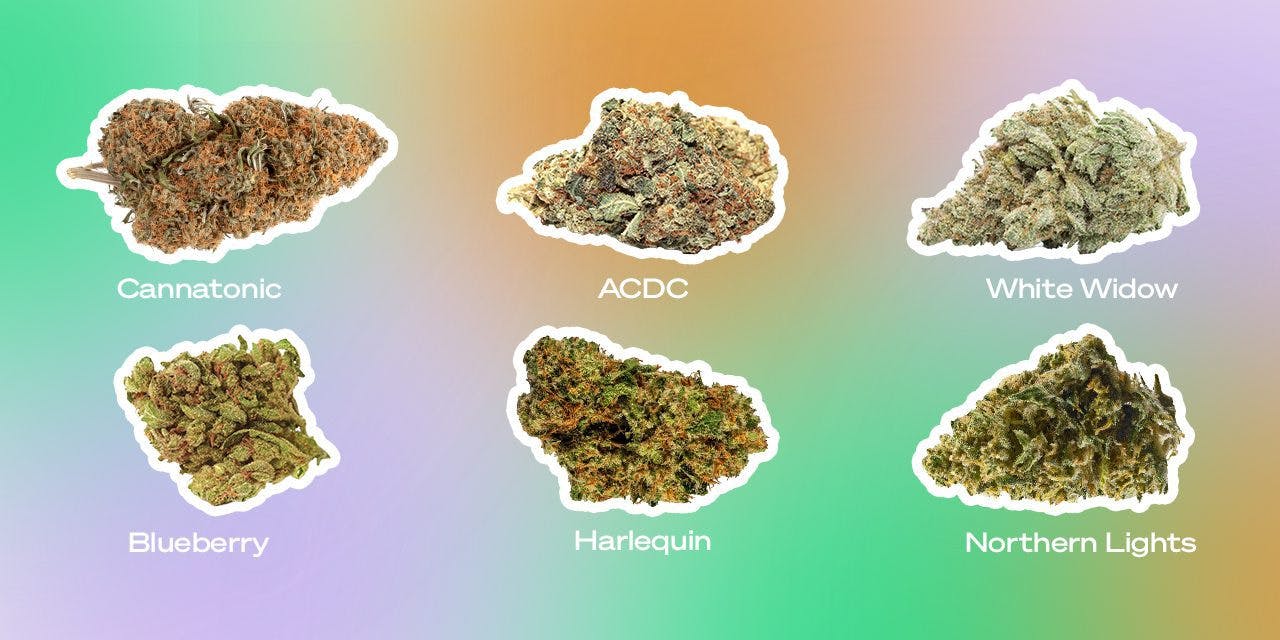8 Best Strains for Migraines

Article written by

Shanti RyleContent Writer
Content reviewed by

Dr. Lewis JasseyMedical Director - Pediatric Medicine
Migraine headaches produce severe, acute head pain that can last for hours or even days. Most people who endure migraines experience a handful of attacks per month, but some live with chronic migraines with more than 15 headaches in the same period. Cannabis has antioxidant and pain-relieving compounds that could help reduce stress and pain associated with headaches/migraines.
While physicians are not sure what causes migraines, specific “triggers” are what set them off in sensitive individuals. As a result, there’s a growing interest in medical marijuana as a tool for treatment and managing migraines, including cluster headaches. While research is scarce, two recent studies support cannabis as a helpful treatment and even preventative for migraines.
Get Your Medical Card
Connect with a licensed physician online in minutes.
How Cannabis Affects Migraines
As noted above, recent research has finally suggested the potential of medicinal cannabis in treating individuals with migraines, despite the hurdles scientists face due to cannabis illegality.
A 2016 study examined 121 adults with migraines who tried cannabis at their doctor’s recommendation. Migraine frequency decreased from 10.4 headaches per month to 4.6, a significant improvement.
Another 2017 study found that cannabis use was an effective preventative for migraines and offered acute treatment. This study found that patients experienced a 55% decrease in a subjective assessment of pain after using cannabis every day for three months.
While we don’t understand the mechanism behind migraines or how cannabis acts on this process, we can speculate. Cannabis has been shown to decrease the sensory experience of pain in other pain disorders (such as chronic pain or neural pain) by slowing the transmission of neurochemicals along pain pathways. By delaying this communication process, we perceive less pain.
Cannabidiol (CBD) is also a potent anti-inflammatory and could be helpful in soothing inflammation-related aspects of a migraine headache. Similarly, the atypical cannabinoid and terpene beta-caryophyllene could help reduce pain sensation and inflammation.
Download Free Guide to CBD
Best Ways to Use Cannabis for Migraines
Migraines come on slowly, so the sooner you notice an attack coming on, the sooner you can take steps to prevent it. Smoking or vaping cannabis are two of the fastest consumption methods, as the cannabinoids enter the bloodstream via the lungs and quickly circulate throughout the body. After inhaling, the effects start within a few minutes and last between two and three hours. This can be especially useful in heading off a migraine before it gets worse or soothing symptoms when you’re mid-attack.
If you notice symptoms of an impending attack, edibles may be your best bet for preventative treatment. They take longer to kick in but last several hours, which can help ensure pain relief for the entirety of the episode, even if it lasts a while. Oil-based tinctures (cannaoil) may provide long-lasting relief and are easier to dose than edibles, as well as have a much quicker onset of around 15-30 minutes.
Sleep is also one of the best remedies for migraines, allowing the brain to reset and rest amid an attack. Cannabis can help you fall asleep more quickly and let sleep work its magic.
Keep in mind that much about the use of marijuana for migraines is still a mystery, including which strains or doses work best. Not all cannabis strains will have a positive effect, so be sure to consult with your physician before choosing a marijuana treatment for migraines.
Best Strains for Migraines
ACDC
ACDC is a high-CBD strain that allows for measurable pain relief without the psychoactive effects of THC. Its high levels of CBD also offer anti-inflammatory benefits, helpful in controlling the pain of migraine symptoms. Dominant terpenes in ACDC include myrcene and beta-caryophyllene.
Canna-Tsu
Canna-Tsu is another high-CBD cultivar capable of producing effective pain relief without euphoric highs. The strain is anecdotally known to produce calm and mental clarity, reportedly able to soothe both migraines and regular headaches. Myrcene, beta-caryophyllene, and limonene are the dominant terpenes in Canna-Tsu.
Harlequin
Harlequin contains approximately a 2:1 ratio of CBD to THC, allowing for decent pain relief from both cannabinoids but still a tempered psychoactive experience. Harlequin is best used at the first sign of migraine symptoms, allowing it to kick in before the headache worsens. The primary terpenes in Harlequin include myrcene, beta-caryophyllene, pinene, and humulene.
Northern Lights
Northern Lights is an older and popular cannabis strain known for its pain-relieving, sedative properties. The cultivar contains more THC than CBD and a profile with more myrcene, beta-caryophyllene, limonene, humulene, and terpinolene. These terpenes work together to relax patients and soothe pain sensations before an attack becomes fully-fledged.
OG Kush
OG Kush is a widely available cultivar with powerful sedative effects that make quick work of much migraine pain. It has higher THC content, so those with low tolerance only need a small dosage, but its slight amounts of CBD contribute to overall pain reduction. OG Kush’s dominant terpenes include myrcene, limonene, humulene, and pinene.
Pineapple Kush
Pineapple Kush is so named for its distinct pineapple flavors, but it anecdotally offers effective pain relief to its users. It features a blend of many terpenes, such as linalool, beta-pinene, myrcene, limonene, and caryophyllene.
Purple Kush
Purple Kush is a powerfully sedative strain with high THC content and sleep-producing terpenes. High levels of myrcene and linalool are highly relaxing, helping users fall into a sleepy euphoria before the worst of the migraine has a chance to appear.
Remedy
Remedy is a strain with about 15% CBD and 1% THC content, making it an effective anti-inflammatory and pain-relieving option unlikely to induce any THC-related psychoactivity. Remedy is often rich in myrcene and pinene.
Get Your Medical Card
Connect with a licensed physician online in minutes.
Frequently Asked Questions
Does sativa or indica help with migraines?
Sativa and indica are terms used to describe the growing characteristics of the cannabis plant and its subspecies. Colloquially, they refer to whether a strain is upper or a downer experience, but these are simplistic distinctions. Whether a strain is “up” or “down” depends on the strain’s chemovar: the collection of cannabinoids, terpenes, flavonoids, and other compounds that contribute to a specific strain’s effect on someone’s system.
What strain is best for migraines?
Our list above covers a few options. However, no one size fits all, and you may want to experiment with different strains and doses to find what works best for you. The first step is to see a Leafwell provider and get your own medical marijuana card.



